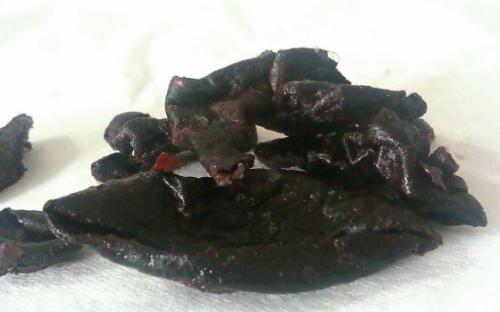Kokam
The kokum is native to the western coastal regions of southern India and is rarely seen beyond this area. Even in India it is used only in the regional cuisines of Gujarat, Maharashrta and several southern states where large glasses of kokum sherbet are downed during parched summer months. In this region the sweltering heat demands refrigerant (cooling) ingredients in food and drink. Kokum is well known to counteract the heat.
Kokum is dark purple to black, sticky and with curled edges. The fruit is often halved and dried, so that the dried seeds are visible in their chambers like a citrus fruit. It is usually available as a dried rind, resembling a thick plum skin. When added to food it imparts a pink to purple colour and sweet/sour taste.
Bouquet: a slightly sweet and sour aroma.
Kokam– Names in different Indian Languages.
Hindi– Kokam , Bengal – Aamsol, Gujrati – Kokam,
Tamil - Kokam.
Nutritional Information
As mentioned in the introduction, kokum’s refrigerant properties are well known. It is useful as an infusion, or by direct application, in skin ailments such as rashes caused by allergies. Kokum butter is an emollient helpful in the treatment of burns, scalds and chaffed skin. The fruits are steeped in sugar syrup to make amrutkokum which is drunk to relieve sunstroke.
Culinary Uses
Kokum has the same souring qualities as tamarind, especially enhancing coconut-based curries or vegetable dishes like potatoes, okra or lentils.
Smoke dried skin of kokum is widely used in preparing fish curry in Kerala.three or four skins being enough to season an average dish.
It is used as a slightly sour spice in recipes from Maharashtra. Kokum yields a peculiar flavour and blackish red colour. It is also used in cuisine from Gujarat, where it is frequently used to add flavor and tartness to dal (lentil soup) for flavor balance, and parts of South India.
It is also included in chutneys and pickles. The skins are not usually chopped but are added whole to the dish. Seasoning should be checked as they are quite salty. Beware of biting on a stone as a few are often left in the skins.
Kokum squash or kokum concentrate is used in preparing a drink (sherbet) which is bright red in colour. Kokum sherbet improves digestion and cools the body during summers.
Storage
Similar to tamarind, kokum skins are usually available as dried rind or fruit, and infused in hot water. The deeper the colour the better the kokum. It will keep in an airtight jar for about a year.
Precaution
Due to its tangy and salty taste it is used very little in the preparation.
